Every potential breeding dog – and as many Kooikers as possible, in fact – should be fully health tested. This doesn’t mean just a vet check, it’s a specific set of tests coordinated with the international breed clubs and recorded in the Register, that in the US will yield a CHIC number, indicating the dog has completed all required tests. These are not diagnostic tests, and are not done in conjunction with a known or suspected health issue – think of them as screening tests. “Failed” tests, and those on dogs not intended for breeding, are equally important for breed-wide knowledge and decision making, so all should be submitted both to OFA and to the Register. Results of health tests completed and submitted are visible both in the Register and its digitized versions Fit2Breed, Zooeasy, and Breedersoft, and on OFA’s website – the Orthopedic Foundation for Animals. Health tests may or may not be required by a dog’s breeder, but any owner can complete them.
There are currently five health tests required for American Kooikerhondjes to earn their CHIC number and thus be “fully health tested.” In OFA, missing health tests can mean EITHER they were not completed, OR they were failed, and the owner opted to withhold publishing those failed results (not recommended). A CHIC (“chick”) number is issued after the 5th health test is submitted to OFA, and a purple “CHIC” symbol appears next to the dog’s name in the OFA database. It is the dog owner’s responsibility to submit paperwork to BOTH OFA and to the VHNK for inclusion in the Register, but a reputable breeder may handle submissions to the Register for their litters. In order to submit health tests, dogs must have permanent identification – a tattoo or microchip – and a registration number with AKC or FCI.
In order to complete the health tests, the dog’s owner will need to arrange veterinary visits and paperwork for the following five tests:
- Bloodwork or swabs for von Willebrand’s disease
- Bloodwork or swabs for ENM (Hereditary Necrotizing Myelopathy)
- Patellas (knees)
- Eyes
- Hips
Dog owners can do OFA testing for any of the other tests OFA keeps data for – hearts, thyroid, dentition, elbows, etc. Often dog owners coming to Kooikers from other breeds that do test for these are inclined to do these extra tests, and that’s acceptable. The breed clubs have worked to identify the issues with the highest priority or likelihood of failure, and test for those – instead of requiring testing for everything possible, which would be so expensive and time-consuming it would deter testing of the “important” issues. OFA will happily take money for as many tests as any owner would like to do, but as the possibility of failure of these other tests across the breed is quite low, we generally focus on these five.
Important 2024 Update: Polymyositis is one of the single biggest threats facing Kooikerhondje health, and luckily, a linkage test for this was developed in 2024! While Polymyositis (PM) testing is not currently part of CHIC requirements, ALL dogs should be tested for this as it has management implications for the life of the dog. It can and should be submitted to OFA and the Register alongside other DNA health testing.
When to Health Test?
Health tests can be done technically in any order, and results submitted to OFA all at once or as each is completed. However, as three of the tests have minimum ages at which they can be done, owners usually split the tests up over time.
- Bloodwork or swabs for von Willebrand’s disease (vWD), Polymyositis and ENM can be done at any age – up to 4 mLs of blood are pulled so the only restriction is the puppy has to be old enough that this won’t cause blood loss problems. Any veterinarian or tech can draw this blood.
- Patellas (knees) minimum age is ONE YEAR. Any veterinarian can complete this test.
- Eyes (formerly known as a CERF exam) minimum age is ONE YEAR. This is done by a veterinary ophthalmologist.
- Hips – minimum age is TWO YEARS. It is recommended that a vet experienced in hip radiographs for OFA take these, so is likely not going to be at the “regular” vet. Usually these vets are found at dog show or club events, “breeder’s days,” or just by word of mouth from experienced local dog owners or breeders.
How To Submit Health Testing?
To OFA
Once each test is completed, the results must be submitted by the owner to OFA, with the exception of the hip radiographs, which many experienced clinics will submit directly to OFA for you. The accompanying online or paper forms can be found at OFA’s Application Forms page – you will be using the Patellar Luxation forms, the Hip And/Or Elbow Dysplasia form, and the DNA Based Genetic Disease forms. The eye exam forms will come from the veterinary ophthalmologist at the appointment.
To VHNK for inclusion in breed databases
Once received, results can be submitted to the Register in various ways:
- Through the dog’s breeder
- Via the NKCUSA’s breeding committee
- Through intermediate regional club collections like the California clubs’ health report form
- Directly to the VHNK via clubregister@vhnk.nl
Important: in order to authorize display of the information you submit, you must complete the VHNK’s Consent Form.
Submissions can be done either at the time the OFA tests are completed, or once they’re posted to OFA’s website. See “Dutch Registry” for more details on submitting to the Registry.
Raw Data from Embark/MyDogDNA/etc to VHNK
To include your dog’s full DNA SNP profile in the Fit2Breed database, you either run a complete test through the labs, or if you’ve split these up, you need to submit raw Embark data independently. Procedures on this change occasionally, so review VHNK’s DNA Testing site for directions.
Testing By Type
DNA: vWD, ENM, Polymyositis, and full DNA SNP profiles
As of 2024, DNA testing for Kooikerhondjes has become much easier as it is now a one-stop-shop. These not only test for von Willebrand’s, ENM, and Polymyositis, but inclusion of their full genotype in the Fit2Breed database is possible with one fell swoop. This is current gold standard genetic health testing and since we can now use buccal swabs, is simple and breeders can complete this testing before puppies even go home.
Steps:
- Complete the VHNK’s order and consent form.
- Purchase swabs and Witness Statements from Combibreed – test H561.
- When they arrive in the mail, swab dogs according to instruction, have vet sign off on verified identity, and return swabs to the lab. It is taking them 1-2 weeks to run these as of mid-2025.
- Once you have the results, submit these to OFA via the DNA Based Genetic Diseases form, and submit to Register.
Patellas
Tests for patella luxation are done by manual manipulation by any veterinarian. Usually puppies will have an annual exam and DHPP booster around a year of age, and this is a good time to ask that the patella OFA exam be included. Fill out the Patellar Luxation form ahead of time and bring it to the appointment (or email it ahead) – I’d strongly encourage you to remember to initial the “Abnormal Results” box so that results other than “normal” are published. The vet will manipulate the dog’s patellas (kneecaps) and tick a box that corresponds with what they are finding – if there is laxity or displacement, permanent or otherwise, they will note the grade of PL. (Grade 1 patellas are relatively common in this breed and due to our small gene pool, don’t automatically restrict a dog from being a breeding candidate.) If your vet is unfamiliar with this, it may be worth asking around for a recommendation for a vet that is experienced in OFA exams for PL. You then will need to send in the paperwork with payment, and again also for inclusion in the Register (see above). Once the result is recorded in OFA, you will receive a certificate from OFA in the mail or by email.
Eyes
Eye exams, or CERF (“surf”) exams, have to be done over one year of age by a board-certified veterinary ophthalmologist. Just like in a human eye exam, they will chemically dilate the pupils and then examine the eyes for any abnormalities. This includes abnormalities both inherited and acquired (the eyes are often damaged by scratches, for instance, or abnormalities like cataracts may form secondarily to an infectious disease). Depending on the clinic, you may not be able to fill out the forms ahead of time, as they are written in triplicate on carbon-copy paper, so ask when you make your appointment what information they want you to bring or prepare. Once the eye exam is done, you will be given one of the triplicate sheets, and a copy of that is what you send in with payment to OFA.
Find a Veterinary Ophthalmologist through word of mouth or through the ACVO’s Search function. Also, Cavalier Health maintains an excellent list of upcoming North American health clinics including eye clinics so this is especially helpful to check out if you want to get more than one health test done at the same time and location (usually, at a dog show).
There are more potential findings on an eye exam than in our other health tests, and not all findings are negative. The codes for results from CERF exams require distilling an array of physical traits into just a handful of codes to appear on the website, which means the nuances of any given finding or abnormality are not completely represented by an OFA database listing. A result in OFA for an eye exam other than “normal” does NOT mean failed, nor does it mean the dog will go blind, nor does it mean it absolutely will pass inherited eye diseases to its offspring. OFA may record “Breeder Option Codes” which indicate that the eye exam was not necessarily “normal” but there is insufficient evidence as to the heritability or severity of the issue to expel the dog from the breeding pool. It is merely a flag that a breeder should do research into the exact issue, including its known heritability (or lack thereof) and possible incidence in family members, before breeding that individual. There are quite a few Kooikers with Breeder Option Codes in OFA, and inherited cataracts are seen in some lines of the breed.
OFA and the ACVO officially recommend retesting eyes annually for every potentially-breeding dog of every breed. This is not generally a recommendation that is followed by either individuals or any of our international Kooiker parent clubs. While it may not be a bad idea to retest eyes prior to a planned breeding if the previous test is many years outdated, the inherited eye diseases seen in Kooikers will generally appear early in life, so will appear on an initial exam. Annual tests are more relevant for breeds plagued with progressive inherited degeneration of vision (classically, like in the disease PRA, progressive retinal atrophy), but PRA and associated degeneration are not typically seen in Kooikers.
Hips
OFA exams for hips are slightly different because the vet’s office can transmit the x-ray images to OFA directly, and they may arrange billing differently for that reason. It’s very important for hip radiographs to find a vet that is experienced in taking OFA radiographs – this is not something taught in vet school and your local vet is likely not the best choice. Positioning needs to be exact, as specified by OFA, otherwise they may refuse to evaluate them, or the result may be inaccurate. Often there are health clinics in conjunction with dog shows, but if you can’t get an appointment there, see if the vet doing the show clinics also has a practice through which you can book OFA radiographs. Otherwise, word of mouth referrals from experienced local breeders and exhibitors are your best bet for finding a good vet for OFA hip radiographs.
Dogs must be 2 years for “official” hip radiographs to count for OFA but dogs younger than that can have a “preliminary” result. As most dogs get them done just after they turn 2, for data-comparison purposes it’s wise to follow that pattern. Conventional wisdom says not to take radiographs of females when they are in heat, or have just finished, but other studies say there is little impact on results. Results can be “passing” consisting of grades of Excellent, Good, and Fair, or “failing” consisting of Borderline, Mild, Moderate, or Severe Hip Dysplasia. As this convention is only used in the US, if you are outside the US looking at an American dog or trying to compare an American dog to its European relatives, check out a hip score conversion table.
Some inexperienced vet clinics will insist on sedation or even full anesthesia for hip radiographs for OFA – the latter is a red flag that this practice isn’t the experienced clinic you are looking for. Some dogs do need sedation in order to stay still on the table for long enough that an image can be captured, but it’s not a requirement. Experienced techs and vets do many or most OFA hip exams without sedation (depending on the temperament and behavior of the dog) and they will scoop up the dog, lay him on his back on the table and hold his legs outstretched, take the picture, and let him up – a procedure that takes all of 5 seconds.
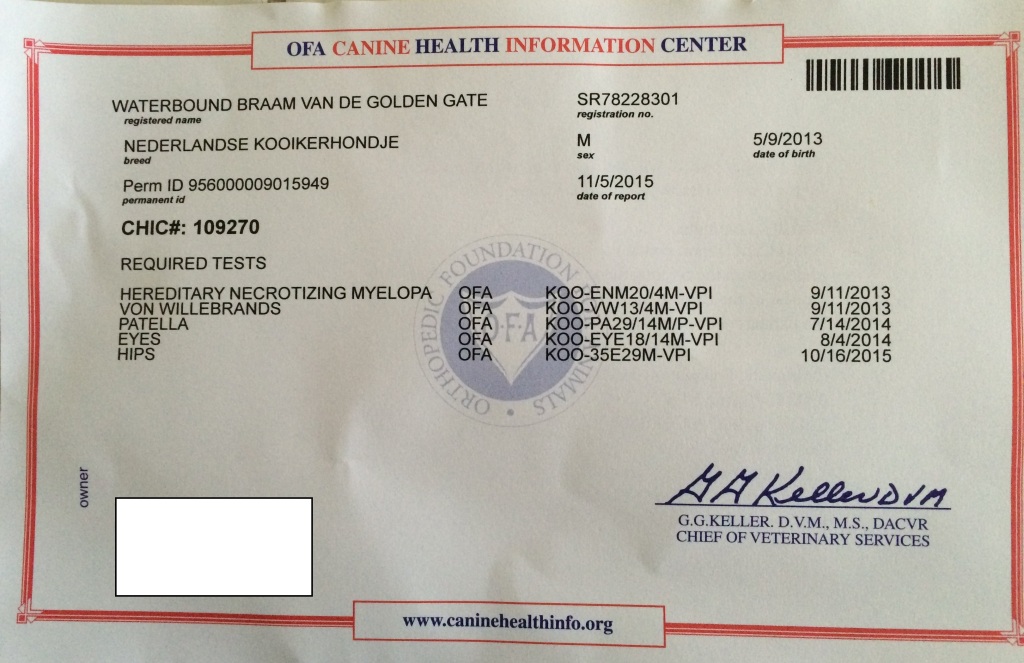

Legacy Information: Blood Tests – ENM and vWD
Please note: the below information is outdated as of 2024. However, because it is still possible to send blood for health testing, it is included below.
Kooikers have an unusual health testing arrangement in that genetic screening blood tests for ALL Kooikers around the world are sent to a single lab in the Netherlands, at the University of Utrecht. No other lab in the world has the capacity to test for Kooiker-specific genetic diseases, and the tests themselves are proprietary and not shared with other labs (nor are other labs likely to independently develop their own tests for Kooikers, given the small potential profit margin from such a rare breed). While one of the tests, von Willebrand’s type III, can be tested for by cheek-swab DNA panels like Embark, this is not sufficient for health testing purposes. (All Kooikers alive today will come back testing “normal/clear” for vWD anyway, so this is our least important test.) Results for ENM can be predicted from parents’ results, especially if both parents are “clear” for ENM, as the mode of inheritance is a simple recessive (like in your high school Punnett square exercises). However, we do not have a “Clear By Parentage” designation in our breed’s health testing. Even if we know the results before the blood is drawn, we still send the blood to Utrecht because this lab uses the genetic data and funds from these submissions to further research into other genetic diseases that are of greater importance to both this breed and all dogs. For instance, blood sent for the vWD test was used to develop the ENM test we now use, and in turn, blood (and money) sent for these two tests is currently being used to develop testing or risk assessment tools for polymyositis – a disease with complex inheritance that can affect any dog breed or mix. For this “greater purpose” reason, we continue to send blood for our CHIC tests to Utrecht, even though it can seem an onerous task especially when the outcome of the testing is already known.
To accomplish these tests (vWD and ENM – technically two separate tests although the blood is used for both):
- Make an appointment with your vet, and ask ahead of time for the vet or vet tech to draw blood during the appointment. This can be done in conjunction with any office visit like a puppy wellness visit or annual – it doesn’t have to be a separate visit as long as the clinic is aware you will need blood drawn during that visit. The vet, tech, and reception will NOT be familiar with what you are asking for, so be prepared with your paperwork and to explain the process.
- Print the Submission Form “DNA Form – English” from the VHNK website and fill out the top part of each page (the dog’s information and your own). Alternatively, you can fill this out on a computer and email it to the clinic to print and sign when you arrive.
- Have the vet draw 1 – 4 mL of blood into an EDTA tube. It can be split across two tubes in case one breaks in transit, but is not required. The tubes should be labelled with the dog’s name and/or registration number, the date, and the breed name. Tubes do NOT need to be refrigerated or cooled.
- Have the vet fill out the remainder of the Submission Form including their name, signature, city and state. They are also attesting that they’ve checked the dog’s chip number.
- Package the blood in some padding or bubble wrap and place in a study envelope or small mailing box WITH the completed submission form. The clinic may do this, or they may give the tubes to you to package, although some clinic staff may balk at giving the tubes back to you. They can package and mail it themselves, or the dog owner can take it to the post office, UPS or Fedex to mail. Try to avoid declaring the package contents as blood, as this may cause snafus at Customs – declare and label the package as “Lab sample from healthy animal for routine genetic testing.” Mail it at a “regular” speed – it is not cooled so does not need to be shipped rapidly. The mailing address is on the form (I’m not listing it here or directly dropping the form, in case it changes over time – always download the most current copy directly from the VHNK’s website!).
- Tests are run every 2 months (the schedule is on the VHNK website) and you will receive a result in the mail, on the same form you submitted. The University will also then send you a bill.
- Make TWO copies of the form you receive from Utrecht with the results, and submit these copies along with TWO copies of OFA’s form “Application for DNA Based Genetic Database” to the OFA. Include payment or your card number on the submission form – remember these are TWO tests (vWD and ENM) so everything about the OFA submission is duplicated. Once OFA receives the forms and payment, they will post to the website. You can submit results to the Register as soon as you receive the paperwork back from Utrecht as well.
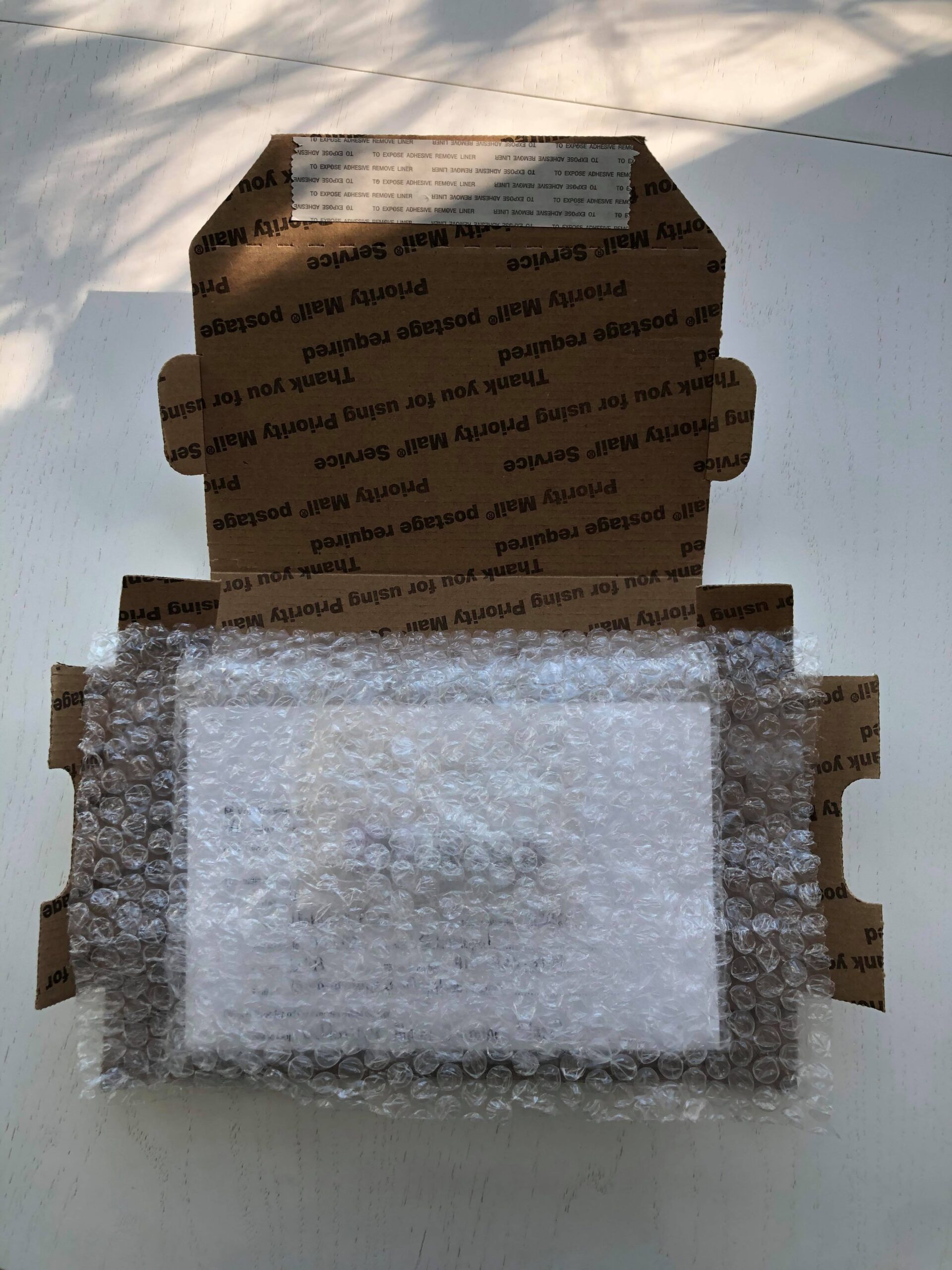
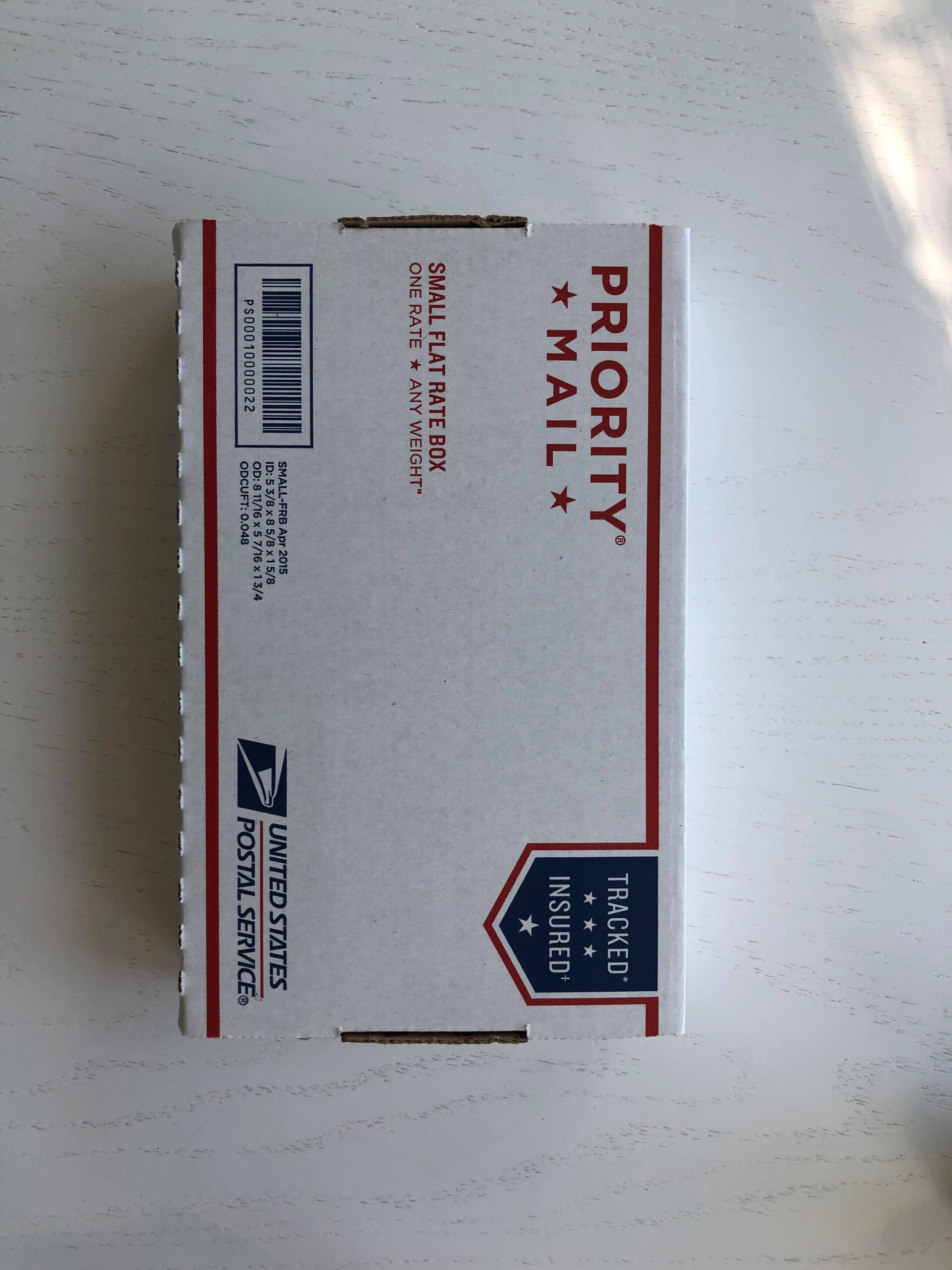
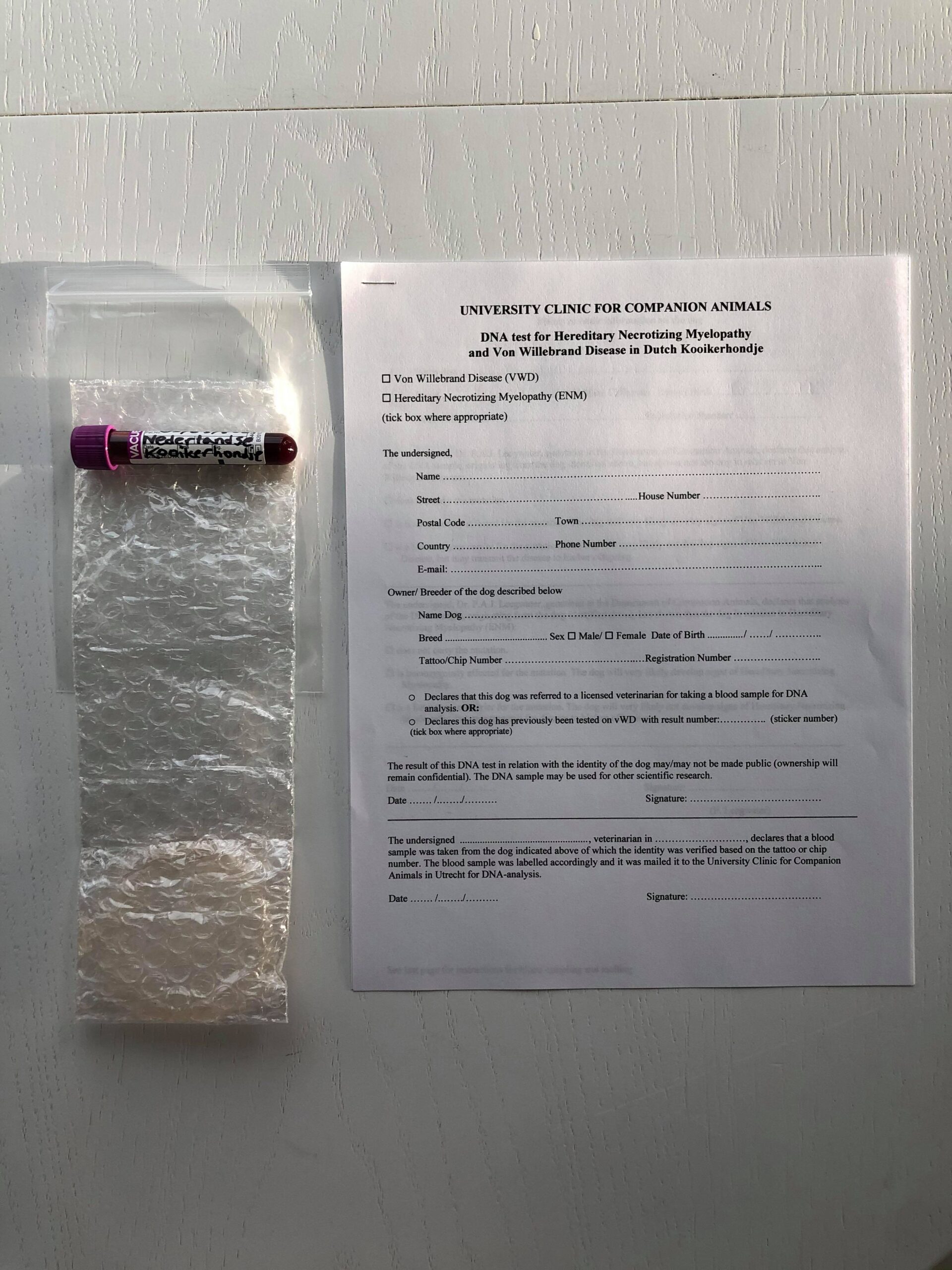
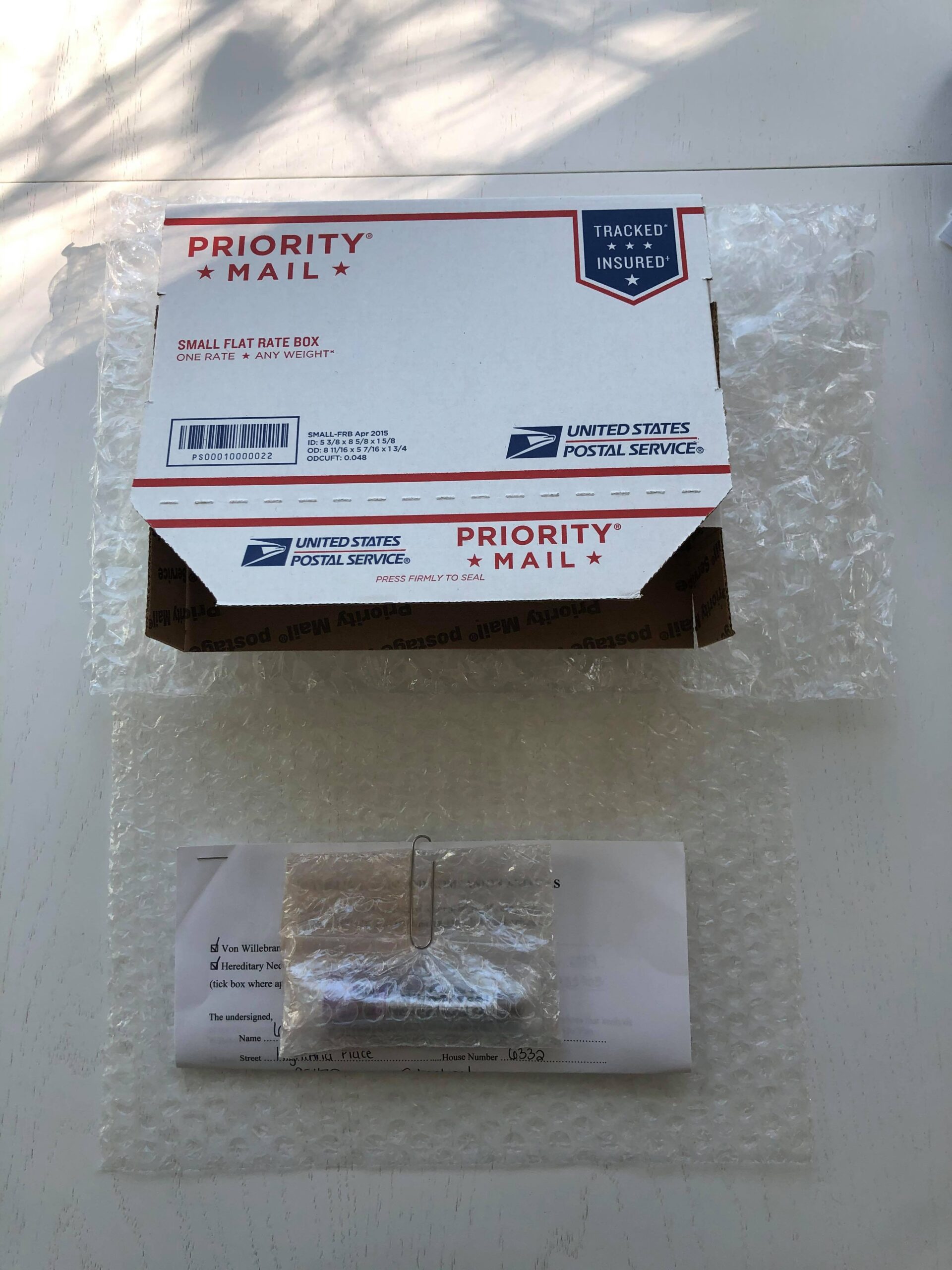

Thanks to Laura for photographing her blood submission for inclusion here!